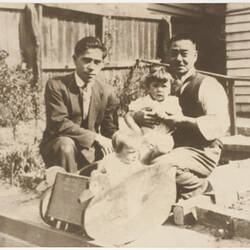Summary
Certificate presented to Setsutaro Hasegawa, by the Japanese Red Cross in recognition of Setsutaro becoming a full time staff member of the Red Cross on 15th December 1926. Setsutaro migrated to Australia from Japan in 1897 at the age of 26, just four years before the introduction of the Immigration Restriction Act which severely limited migration to Australia from countries in Asia. He established a laundry business in Geelong and by 1911 he had married an Australian-born woman and had three children.
In 1941 Setsutaro was arrested as an enemy alien and sent to Tatura internment camp in northern Victoria. Released early in 1943 due to his age and poor health, unlike most Japanese interns he was not deported to Japan after the War. Setsutaro remained in Geelong for the rest of his life and died in 1952.
Physical Description
Single paper sheet in portrait format, cream with decorative brown border with vines and flowers. It has four folds. At the centre of the right border is the international red cross symbol. Within the border is Japanese text in black ink and three red stamps. There is also a paper envelope with three Japanese characters in black on the front.
Significance
The Hasegawa collection enables the exploration of a number of important historical themes relating to migration, working life, and wartime internment in Victoria. Late nineteenth century and early to mid twentieth century Japanese migration and settlement experiences are little represented in the museum's collections and this collection of clothing, documents, personal items and photographs helps to redress.
More Information
-
Collecting Areas
-
Acquisition Information
Donation from Andrew Hasegawa, Andrew Hasegawa, 08 Feb 2008
-
Presented By
-
Presented To
Mr Setsutaro Hasegawa, Geelong, Victoria, Australia, Dec 1926
-
Inscriptions
Extensive Japanese text in black ink.
-
Classification
Migration, Settlement - cultural & social life, Correspondence
-
Category
-
Discipline
-
Type of item
-
Overall Dimensions
300 mm (Width), 217 mm (Height)
-
References
5 family photographs (need originals from donor to scan)
-
Keywords
Certificates, Charities, Healthcare & Medicine, Human Rights, Japanese Communities, Japanese Culture, Japanese Immigration

